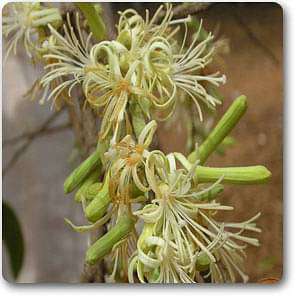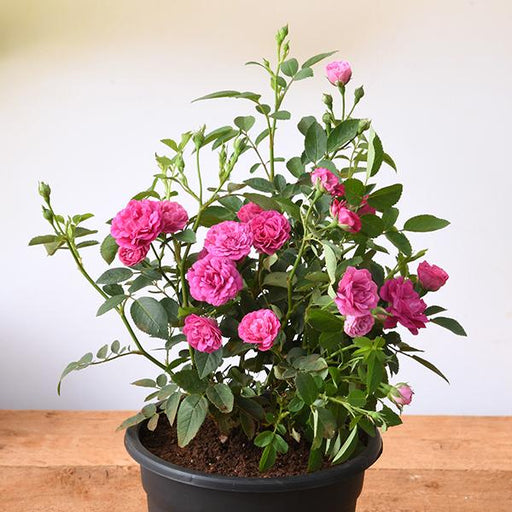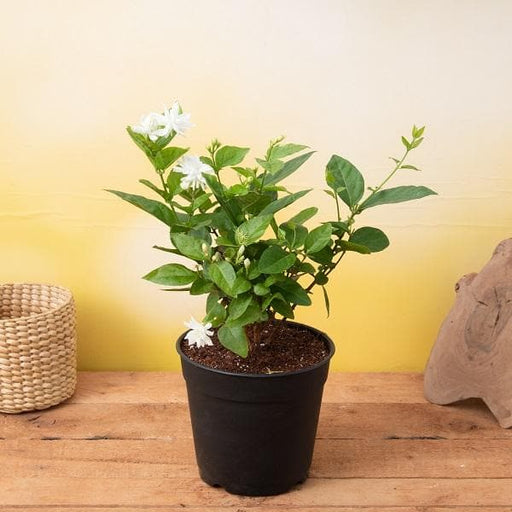
Sage-leaved alangium - Plant
(MRP Inclusive of all taxes)
- Shipping ₹79 for entire order
- Dispatch in 7 days
- Country of origin: India

(MRP Inclusive of all taxes)
 Save 29%
Save 29%
Air Purifier Money Plant with Pot The Air Purifier Money Plant, also known as Pothos or Epipremnum aureum, is a stunning indoor plant that...
View full details
 Save up to 15%
Save up to 15%
Peace Lily, Spathiphyllum - Plant The Peace Lily, scientifically known as Spathiphyllum, is a stunning houseplant celebrated for its elegant white...
View full details
 Save 25%
Save 25%
Jasminum sambac, Mogra, Arabian Jasmine - Plant Jasminum sambac, commonly known as Mogra or Arabian Jasmine, is a fragrant flowering plant...
View full details
 Save 18%
Save 18%
Combo Constituents Includes the Parijat Tree (Night-Flowering Jasmine), a culturally significant plant with fragrant flowers. Description The Pari...
View full details
 Save 25%
Save 25%
Miniature Rose, Button Rose (Any Color) - Plant The Miniature Rose, also known as the Button Rose, is a charming and compact flowering plant that ...
View full details Save 25%
Save 25%
Damascus Rose, Scented Rose (Any Color) - Plant The Damascus Rose, also known as Rosa damascena, is a timeless symbol of beauty and romanc...
View full details
 Save 17%
Save 17%
Beautiful Fragrant Mogra, Arabian Jasmine Plant with Pot The Beautiful Fragrant Mogra, also known as Arabian Jasmine (Jasminum sambac), is...
View full details Save 15%
Save 15%
Pack of Vermicompost and Neem Cake for House Plants Transform your indoor garden with our premium Pack of Vermicompost and Neem Cake, spec...
View full details
Pack of Plant Growth and Flower Boosters Unlock the full potential of your garden with our Pack of Plant Growth and Flower Boosters! This ...
View full details Save 38%
Save 38%
Combo of Jeevamrut and Neem Raksha for Easy Growth and Protection of Houseplants Transform your indoor garden with our exclusive combo of ...
View full details Save 22%
Save 22%
Plant Nutrients Kit (Pack of 16) for a Healthy Garden Transform your garden into a lush paradise with our Plant Nutrients Kit, featuring 1...
View full details Save 16%
Save 16%
Combo of Top Plant Fertilizers Elevate your gardening game with our exclusive Combo of Top Plant Fertilizers, featuring two bags of premiu...
View full details Save 24%
Save 24%
Pack of 4 Additives to Make Soil Healthy and Nutrient Rich Transform your garden into a thriving ecosystem with our Pack of 4 Additives de...
View full details Save 30%
Save 30%
Transform your gardening experience with our premium Combo of Perlite and Vermiculite. This unique blend is designed to enhance soil aeration and ...
View full details Save 27%
Save 27%
Combo of 2 Vermicompost and Cocopeat - Enrich Your Soil Naturally! Transform your garden into a thriving ecosystem with our Combo of 2 Ver...
View full details
 Save 35%
Save 35%
Best 6 Plants for Perfect Indoor Garden Transform your living space into a lush oasis with our curated collection of the Best 6 Plants for a...
View full details
 Save up to 50%
Save up to 50%
Mini Succulent Garden Pack Transform your space with our Mini Succulent Garden Pack, featuring a delightful collection of 4 any variety beautiful s...
View full details
 Save 30%
Save 30%
5 Best Fragrant Plants Transform your garden or indoor space into a fragrant paradise with our curated selection of the 5 Best Fragrant Plants. Th...
View full details
 Save 24%
Save 24%
Set of 2 Bonsai Looking Grafted Adeniums Transform your indoor or outdoor space with our exquisite Set of 2 Bonsai Looking Grafted Adenium...
View full details Save 45%
Save 45%
Top 4 Die Hard Succulents Pack Transform your indoor or outdoor space with our Top 4 Die Hard Succulents Pack, featuring a curated selecti...
View full details
 Save 30%
Save 30%
5 Best Indoor Plants Pack Transform your living space into a lush oasis with our '5 Best Indoor Plants Pack.' This carefully curated collection fe...
View full details
 Save 25%
Save 25%
Set of 4 Evergreen Air Purifier Plant Pack Transform your indoor space into a lush, green oasis with our Set of 4 Evergreen Air Purifier Pla...
View full details| SrNo | Item Name |
|---|---|
| 1 | Sage-leaved alangium - Plant |
The Sage-leaved Alangium (Alangium salviifolium) is a remarkable evergreen shrub native to tropical regions of Asia and Africa. Known for its aromatic sage-like leaves, this plant not only adds aesthetic value to gardens but also serves various ecological purposes. With its delicate white flowers and small, round fruits, it attracts pollinators and provides food for wildlife, making it a vital component of its ecosystem.
What sets the Sage-leaved Alangium apart is its unique combination of beauty and utility. This plant is revered in traditional medicine for its anti-inflammatory and analgesic properties. Its leaves are often used in herbal remedies, showcasing the plant's cultural significance. Additionally, its resilience to drought makes it an excellent choice for sustainable landscaping.
One of the special features of the Sage-leaved Alangium is its ability to thrive in poor soil conditions, making it an ideal choice for eco-friendly gardens. Its lush foliage not only enhances the visual appeal of any landscape but also contributes to soil health by preventing erosion.
The sage-leaved alangium, also known as Alangium salviifolium, is a botanical wonder that brings a touch of elegance to any garden. With its lush, sage-green leaves and delicate white flowers, this tree is like the sophisticated cousin of the plant world, always dressed to impress.
Planting this beauty is like hosting a garden party; you want to make sure it has enough space to mingle with other plants. Choose a sunny spot with well-drained soil, and watch as it grows into a stunning centerpiece that will have your neighbors green with envy.
Caring for your sage-leaved alangium is a breeze. Just give it a little water, some occasional pruning, and it will reward you with a lush canopy that provides shade and a habitat for local wildlife. It’s like having a pet that doesn’t require walks!
This tree isn’t just a pretty face; it offers numerous benefits. From its medicinal properties to its ability to attract pollinators, the sage-leaved alangium is the overachiever of the plant kingdom, always ready to lend a helping leaf.
Incorporating sage-leaved alangium into your landscaping is like adding a splash of color to a black-and-white movie. Its unique foliage and flowers can transform any dull garden into a vibrant oasis, making it the star of your outdoor space.
If you’re looking for a fast-growing tree, the sage-leaved alangium is your go-to. It’s like the Usain Bolt of the plant world, quickly reaching impressive heights and providing shade in no time. Just be prepared for its rapid rise to fame!
Propagating sage-leaved alangium is as easy as pie. Whether you choose seeds or cuttings, this tree is eager to spread its roots and charm. Just remember, patience is key; good things come to those who wait!
Fear not, for the sage-leaved alangium is a tough cookie when it comes to pests. While it may attract a few curious critters, it generally stands strong against the usual suspects, making it a low-maintenance choice for any gardener.
This tree is a wildlife magnet! Birds, bees, and butterflies flock to its flowers, turning your garden into a bustling ecosystem. It’s like hosting a wildlife convention right in your backyard, and everyone’s invited!
The sage-leaved alangium has a rich history in traditional medicine. Its leaves and bark have been used for various ailments, making it the herbalist’s secret weapon. Who knew a tree could be both beautiful and beneficial?
This tree is the ultimate survivor, thriving in various climates. Whether you live in a tropical paradise or a temperate zone, the sage-leaved alangium adapts like a chameleon, proving that it’s ready for any gardening challenge.
Urban gardeners rejoice! The sage-leaved alangium is perfect for city living. Its compact size and resilience make it an ideal choice for small spaces, allowing you to bring a slice of nature to your concrete jungle.
Sage-leaved alangium, or Alangium salviifolium, is a charming shrub that boasts aromatic leaves resembling sage. This plant is a delightful addition to gardens, offering both beauty and a hint of culinary flair. Its unique foliage and subtle flowers make it a favorite among plant enthusiasts looking to spice up their green spaces.
Caring for Sage-leaved alangium is a breeze! It thrives in well-drained soil and loves a sunny spot. Water it moderately, allowing the soil to dry between drinks. Prune occasionally to maintain its shape and encourage bushy growth. With a little love, this plant will reward you with lush foliage and a delightful aroma.
Absolutely! Sage-leaved alangium can be a quirky indoor companion. Just ensure it gets plenty of bright, indirect sunlight and a pot with good drainage. Keep the humidity up, and it’ll thrive like a diva in your living room. Just don’t forget to give it a little pep talk now and then!
Yes, indeed! Sage-leaved alangium is like the bouncer of the plant world—deer tend to steer clear of its aromatic leaves. This makes it a fantastic choice for gardens in deer-prone areas. So, plant it with confidence, knowing your garden will remain a safe haven for your beloved blooms.
Sage-leaved alangium isn’t just a pretty face! Its leaves are known for their medicinal properties, traditionally used in herbal remedies. Plus, it attracts pollinators, making your garden a buzzing hotspot. With its aesthetic appeal and practical uses, this plant is a multitasking marvel that deserves a spot in your garden.
Sage-leaved alangium blooms in the late spring to early summer, showcasing delicate, creamy-white flowers. These blooms may not steal the show, but they add a subtle charm to the plant. So, while you’re waiting for the flowers, enjoy the lush foliage that keeps your garden looking fabulous all year round!
Sage-leaved alangium can reach heights of 3 to 6 feet, depending on its growing conditions. It’s like the Goldilocks of plants—not too tall, not too short, just right for adding structure to your garden. With a little pruning, you can keep it at the perfect height for your landscape dreams.
Sage-leaved alangium has a bit of a rebellious streak—it can tolerate short periods of drought once established. However, it prefers consistent moisture to truly thrive. Think of it as a plant that enjoys a spa day but can handle a little roughing it when necessary. Just don’t forget to pamper it occasionally!
Sage-leaved alangium is a bit picky about its soil, preferring well-drained, loamy conditions. While it can tolerate various soil types, it won’t thrive in heavy clay or overly soggy situations. So, give it the soil it craves, and it’ll reward you with lush growth and aromatic leaves that make gardening a joy.
Fertilizing Sage-leaved alangium is like giving it a gourmet meal—once or twice a year with a balanced fertilizer should do the trick. Spring is the best time to feed it, giving it the energy boost it needs for the growing season. Just don’t overdo it; this plant prefers a light touch!
Fear not! Sage-leaved alangium is not an invasive plant. It plays nicely in the garden without taking over. This makes it a great choice for those looking to add beauty without the worry of a botanical takeover. Plant it with confidence, knowing it will enhance your garden without causing chaos.
You can find Sage-leaved alangium at local nurseries, garden centers, or online plant retailers. Just make sure to check the plant’s health before bringing it home. With a little luck, you’ll soon have this aromatic beauty gracing your garden, ready to impress your friends and neighbors with its charm!